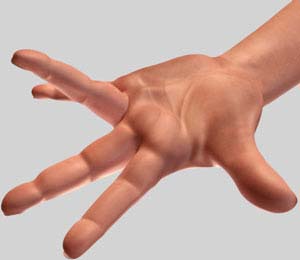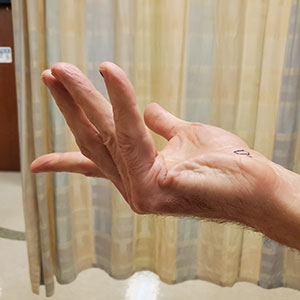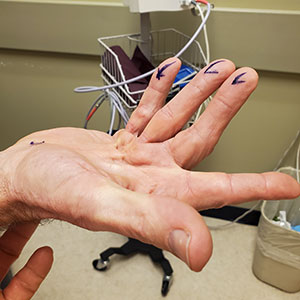
What is Dupuytren's Contracture?
Dupuytren's contracture is a hand condition where thickening of the underlying fibrous tissues (palmer fascia) of the palm causes the fingers to bend towards the palm. This makes it difficult to fully straighten the affected fingers. It commonly occurs in the ring finger and little finger. Occasionally, the middle finger is affected, but the thumb and index finger are rarely affected.
Causes of Dupuytren's Contracture
Dupuytren's contracture is caused from excessive production of collagen which is deposited under the skin. The cause of Dupuytren's contracture is unknown. However, there are certain risk factors that may increase your chances of developing the condition. These can include the following:
- Age: More frequently around age 40
- Social habits: Smoking and drinking alcohol
- Medical conditions: Diabetes, alcoholism, cirrhosis of the liver and seizure disorders
- Gender: More common in males than females
- Heredity: Condition tends to run in families
- Ancestry: Most commonly affected are northern Europeans and people of Scandinavian descent
Symptoms of Dupuytren's Contracture

Dupuytren's contracture is a condition that usually progresses slowly over many years and is not usually painful. However, some cases may progress rapidly and be painful. The most commonly observed symptoms of Dupuytren's contracture are lumps or nodules in the palm of the hand, difficulty in straightening the fingers and contracture of the nodules which form tough bands under the skin. The inability to place your palm flatly on a hard surface (positive table top sign) is a common finding in more advanced cases. Early on there may be just nodules and cords with minimal contracture. In these cases, Dr. Miller will often advise you to follow up when you can not place your palm flat on a hard surface. It is at this time that surgical options are often discussed.
Diagnosis of Dupuytren's Contracture

Dupuytren's contracture is diagnosed based on your history and a physical examination, without the need for any special tests. The physical examination may involve applying pressing on different parts of your hands and fingers to assess for hardened knots or tough bands of tissue.
Conservative Treatment for Dupuytren's Contracture
You may not need treatment for Dupuytren's contracture if the condition is not affecting your ability to perform daily activities. However, if you are experiencing pain or are having difficulty using your hands for everyday activities, Dr. Miller will recommend conservative treatment options to treat your condition. Treatment options will vary depending on the severity of your condition. The conservative approaches include:
- Heat: Applying heat to the palms of your hand prior to massage or exercise can help to loosen the tissues.
- Massage: Gently massage the thickened tissues of the palm.
- Exercises: Stretching exercises such as bending the fingers away from the palm may be useful.
- Injections: Steroid injections in the palm may be administered to relieve local inflammation in cases of a painful nodule or cord.
- Collagenase injection: An enzymatic drug (Xiaflex) that breaks down collagen can be injected into the corded tissue to soften and weaken the contracture. The physician then manipulates the area manually to break up the tissue. This is oftentimes covered by insurance but will require approval. The injection is given one day and then you will follow up a few days later for the manipulation after local anesthetic is given. Our Certified Hand Therapist will fabricate an extension splint the same day.
- Needle aponeurotomy: This procedure involves inserting a small needle into the thickened palm tissue and manipulating it to loosen and break up the contracting tissue. Ultrasound may be used to guide the needle to avoid hitting nerves or tendons.
Surgical Procedure for Dupuytren's Contracture
If the contracture progresses resulting in functional difficulties and your quality of life is adversely affected, Dr. Miller may recommend a surgical procedure to remove a portion of the diseased palmer fascia. This improves the function of the hand by reducing or eliminating the contracture of the digit involved.
This surgery is usually performed in an operating room under local, regional anesthesia or a general anesthetic on an outpatient basis. Your surgeon makes a small incision to the affected palm area. Your surgeon then removes the thickened fibrous tissue causing the contracture. The incision is then closed with sutures and covered with a sterile dressing. At times, portions of the wound may be left open to heal by secondary intention. Rarely, in more severe cases a local skin graft may be used to cover a larger skin deficit.
Complications following Surgery for Dupuytren's Contracture
Complications can be medical (general) or specific to hand surgery. Medical complications include those of the anesthetic and your general wellbeing. Some of the complications associated with hand surgery include:
- Stiff fingers
- Infection
- Nerve damage causing weakness or loss of feeling in the hand area
- Injury to the arteries of the fingers/hand
- Recurrence of the condition















